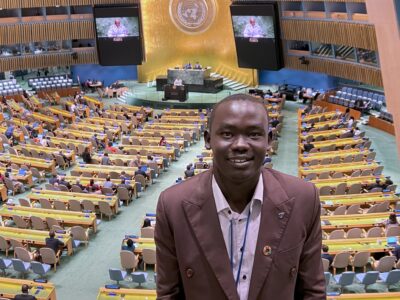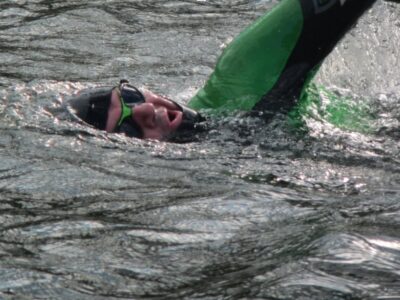
Former MPA-ESP (14’) student Dannie Dinh decided to pursue a career in the nonprofit sector after completing her graduate degree. For the past two years, Dannie has been working with the International Research Institute for Climate and Society (IRI) at Columbia University’s Earth Institute.
Beyond her professional work, Dannie’s personal interest lies in the field of art and design. Her long-term vision is to use her creativity and artistic expression to raise awareness of sustainability among young people and the general public. She believes that art is a powerful means of communication that can help make complex scientific concepts like climate change more personal, tangible and more closely related to our daily lives, and in turn lead to more socially conscious behavior.
Varsha Doshi, SUMA Class of 2016 and ESP intern, sat down with Dannie to learn more about her interests and career path since graduation.
1. What is your current job? Are there any special projects that you are working on?
I am working as the Special Assistant to the Director at the International Research Institute for Climate and Society (IRI) and as a communications consultant for the Climate Change, Agriculture and Food Security (CCAFS) program’s Flagship on Climate Risk Management.
I currently serve on the MPA-ESP Alumni Board as the Earth Institute liaison and New York region coordinator. I have been volunteering with the nonprofit collaborative GreenspaceNYC for their summer pop-up series Civic Art Lab.
Along with fellow alumnus Christophe Jospe (ESP’14). I will be hosting a free workshop entitled Sketching Our Future World on July 31 in New York City, which aims to use art as an accessible approach to promote awareness on climate change issues. Participants in the workshops will be introduced to new ideas and innovations in science and technology that can help curb the impacts of climate change, and will be invited to draw on paper what these ideas would look like in everyday life. We look forward to bringing our fellow alumni, as well as future ones, to the event to partake in discussion, share expertise, and network with one another and with community members from all walks of life.
2. Can you please share your career path after you graduated from the program and how you found your current position?
During the last semester of the MPA-ESP program, I researched corporate risk and sustainability disclosure to produce a white paper and provide business development consultation for a startup firm. However, I have always been more interested in working in the public and nonprofit sector. Upon graduating, I interned at the City University of New York’s Office of Environmental Health, Safety, and Risk Management until I joined IRI.
3. What are some of the most rewarding and challenging aspects that you face in your career?
A great part of my current job is to work on institutional issues, so the challenges that I face are the same ones faced by the IRI as an institute and by many others in the nonprofit sector. These challenges, from securing funding continuity to reconciling policies affecting our operations, seem to be outside our scope of work but they have tremendous implications for our ability to carry out the work. There is always a bit of stress, uncertainty, and frustrating constraints working in the nonprofit sector. But being able to believe in the organization’s mission, knowing that I am contributing to that mission, and working alongside passionate and dedicated colleagues are really great motivation and inspiration for me to continue my work.
4. What skills and knowledge from the MPA-ESP program have proven to be most useful in your professional career so far?
I rely often on the skills I learned through the workshops: writing, editing, synthesizing information and inputs, producing concise reports and presentations, and project management. Statistical analysis, climatology, sustainability management, financial management are very helpful for my current work as well. But the most important things I gained through the program are perhaps the relationships I formed. Many of the classmates, liaisons, professors, and professional contacts I met through the MPA-ESP are now my friends, colleagues, mentors, and collaborators. When anyone in our class needs advice, expertise, or just great discussions and ideas, we are each other’s readily available go-to resource.
5. What has been your biggest accomplishment associated with sustainability in your current position?
As it developed, the 2015 El Niño event was predicted to be one of the largest El Niño events of the last 50 years, with significant implications for global food, water, health, energy and disaster-response systems. It presented a unique opportunity for the IRI to invite governments, the media, scientists, economists, and humanitarian agencies to come together to share past experience and discuss the research and development agenda for climate resilience and sustainable development. I worked with an international committee to lead the planning and coordination of the conference and worked with our communications team to produce a summary report of the ideas and perspectives stemming from the conference.
6. Where do you see yourself in the next 5 years?
I would like to work with or start a nonprofit initiative to encourage integration of sustainability in art and design and use art projects to increase public awareness of sustainability and climate issues. As there is no shortage of nonprofit organizations in the New York City area, my focus would be on empowering and collaborating with existing groups and initiatives for bigger, more sustainable projects with lasting impacts.
7. What advice would you provide to current students or prospective students interested in pursuing the MPA-ESP program?
Be truly present and take full advantage of the program and its people and resources. Working in the student groups offered a diverse body of expertise, and many personalities to solve problems with, so don’t be concerned if you are someone who is not drawn to “group work.” Every interaction inside and outside of class is a learning opportunity. What I learned from my classmates was just as valuable as what I learned from the professors and teaching assistants.



